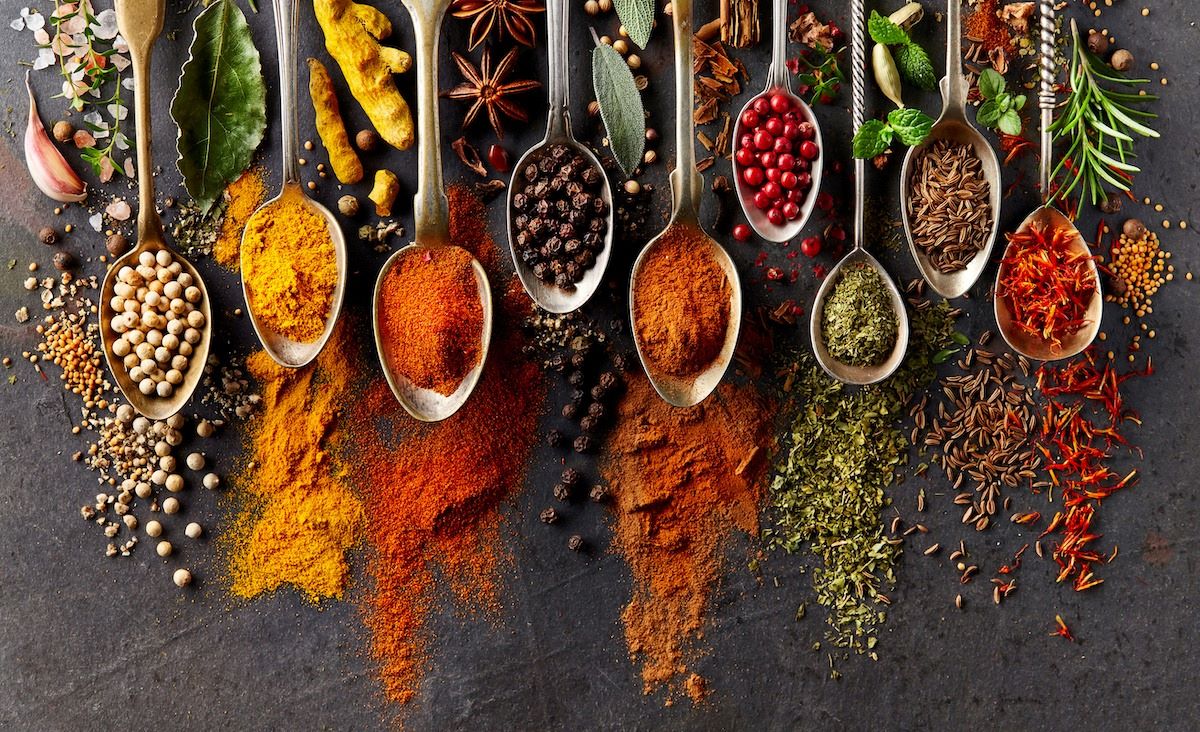
Spices are an essential part of culinary traditions around the world, adding flavor, aroma, and complexity to dishes. From the fiery heat of chili peppers to the warm earthiness of cinnamon, spices have the power to transform a simple meal into a memorable culinary experience. Whether you’re a seasoned chef or an enthusiastic home cook, learning about the fascinating world of spices can enhance your skills in the kitchen and deepen your appreciation for different cuisines.
In this article, we’ll explore 19 intriguing spice facts that will not only ignite your curiosity but also enhance your understanding of these flavorful ingredients. From historical anecdotes to health benefits, we’ll delve into the diverse and rich history of spices and their significance in global cuisine. So, grab your apron and prepare to spice up your knowledge about the wonderful world of spices!
Key Takeaways:
- Spices like cinnamon, turmeric, and ginger not only add flavor but also offer health benefits like aiding digestion and providing medicinal properties.
- Each spice, from saffron to black pepper, brings its own unique characteristics, enhancing dishes with their distinct flavors and aromas.
Cinnamon comes from the bark of a tree.
Cinnamon is derived from the inner bark of trees belonging to the Cinnamomum genus. It is one of the oldest spices known to mankind and is widely used in both sweet and savory dishes.
Turmeric has medicinal properties.
Turmeric is known for its numerous health benefits. It contains a compound called curcumin, which has powerful anti-inflammatory and antioxidant properties. It has been used in traditional medicine for centuries.
Paprika adds vibrant color to dishes.
Paprika is a spice made from dried and ground red peppers, giving it a rich red color. It is commonly used as a garnish and adds a mild, sweet, and slightly smoky flavor to various dishes.
Ginger can help with digestion.
Ginger has been utilized for centuries to aid digestion. It can reduce nausea, alleviate stomach discomfort, and promote healthy digestion. Ginger is commonly used in both culinary and medicinal applications.
Saffron is the most expensive spice in the world.
Saffron, derived from the Crocus flower, holds the title for being the most expensive spice. It takes a large number of delicate stigmas to produce a small amount of saffron, which contributes to its high price.
Cumin is commonly used in Indian and Mexican cuisines.
Cumin is a popular spice in Indian and Mexican cooking. It adds warmth, earthiness, and depth of flavor to a variety of dishes, such as curries, stews, and chili.
Cardamom is known as the “Queen of Spices.”
Cardamom is often referred to as the “Queen of Spices” due to its rich aroma, intense flavor, and versatility in both sweet and savory dishes. It is used in cuisines around the world.
Cloves have a strong and distinct taste.
Cloves have a strong, pungent flavor and fragrance. They are often used in baking, pickling, and cooking, adding a warm, sweet, and slightly peppery taste to dishes.
Mustard seeds come in different varieties.
Mustard seeds are available in various colors, including yellow, brown, and black. Each variety has a slightly different flavor profile, with the yellow seeds being the mildest and black seeds being the spiciest.
Nutmeg is used in both sweet and savory recipes.
Nutmeg is a versatile spice used in both sweet and savory dishes. It has a warm, slightly sweet taste and is commonly used in baking, sauces, soups, and beverages.
Coriander is the seed of the cilantro plant.
Coriander seeds are obtained from the coriander plant, which also produces cilantro leaves. The seeds have a citrusy, floral flavor and are widely used in various cuisines worldwide.
Chili peppers contain capsaicin, which causes the spicy sensation.
Chili peppers derive their heat from an active component called capsaicin. The higher the concentration of capsaicin in a chili pepper, the spicier it is.
Black pepper is the most widely used spice in the world.
Black pepper is a staple spice found in nearly every kitchen around the globe. It adds a mild, pungent flavor to dishes and is often used in both savory and sweet recipes.
Fenugreek has a strong aroma and taste.
Fenugreek seeds have a distinctive aroma reminiscent of maple syrup and a slightly bitter taste. They are commonly used in Indian, Middle Eastern, and Mediterranean cuisines.
Bay leaves are used to add flavor to soups and stews.
Bay leaves are dried leaves from the bay laurel tree. They are commonly used to add flavor to soups, stews, and braised dishes, imparting a subtle, earthy taste.
Vanilla comes from the seed pods of the orchid plant.
Vanilla is derived from the seed pods of specific orchid species. It is one of the most popular and expensive spices due to its sweet, aromatic flavor and its extensive use in baking and desserts.
Cloves have natural numbing properties.
Cloves contain a compound called eugenol, which acts as a natural numbing agent. They are often used to alleviate toothaches and sore throats.
Caraway seeds are commonly used in European cuisine.
Caraway seeds are widely used in European cuisine, particularly in dishes from Germany, Austria, and Eastern European countries. They have a slightly sweet and nutty flavor.
Star anise is a key ingredient in Chinese Five Spice.
Star anise is a star-shaped spice commonly used in Chinese cuisine, especially in the popular spice blend known as Chinese Five Spice. It has a strong licorice-like flavor.
Spices add flavor, aroma, and personality to our favorite dishes. Let’s dive deeper into the fascinating world of spices with these 19 Spice Facts! From the aromatic cinnamon to the fiery chili peppers, each spice brings its own unique set of characteristics to the culinary table.
Cinnamon, for instance, is obtained from the inner bark of certain trees and has been utilized for centuries for its warm and sweet flavor. Turmeric, on the other hand, not only adds a vibrant yellow color to dishes but also possesses medicinal properties due to its compound curcumin. Paprika, made from ground red peppers, provides dishes with a rich and mildly smoky flavor that enhances their appearance too.
Ginger, known for its spicy and zesty taste, has been used passionately in various cuisines for its digestion-aiding abilities. Saffron, considered the most expensive spice in the world, is derived from the delicate stigmas of the Crocus flower and imparts a distinctive floral aroma and golden color to dishes. The versatile cumin, commonly found in Indian and Mexican cuisines, adds earthiness and warmth to a wide array of recipes.
Cardamom, often referred to as the “Queen of Spices,” is prized for its intense flavor and aroma, which makes it a valuable ingredient in both sweet and savory dishes. The pungent and fragrant cloves bring a warm, peppery taste to baked goods and savory recipes. Mustard seeds, available in different colors, add depth and piquancy to various dishes.
Nutmeg, with its sweet and slightly nutty taste, is used in both sweet and savory recipes, from baked goods to sauces. Coriander, derived from the seeds of the cilantro plant, contributes a citrusy and floral flavor to a wide range of cuisines worldwide. Chili peppers, thanks to the compound capsaicin, bring the heat and spice to countless dishes, thrilling spice enthusiasts.
Black pepper, the most widely used spice globally, adds a mild pungency to almost every type of cuisine. Fenugreek, with its strong aroma and taste, is common in Indian, Middle Eastern, and Mediterranean cooking. Bay leaves, dried leaves of the bay laurel tree, infuse soups and stews with their subtle earthy flavor.
Vanilla, derived from the seed pods of orchid plants, is used extensively in baking and desserts due to its sweet and aromatic essence. Cloves, with their numbing properties, have been used traditionally to alleviate dental and throat-related issues. Caraway seeds, popular in European cuisine, offer a sweet and nutty taste.
Lastly, star anise is a star-shaped spice commonly used in Chinese Five Spice blend, providing a strong licorice-like flavor. Each spice in this list has its own story, taste, and usage, elevating the culinary experience with its unique charm.
So, the next time you sprinkle cinnamon on your oatmeal, stir turmeric into a curry, or reach for that jar of black pepper, remember the vast world of flavors and the fascinating journey these spices have undergone to tantalize our taste buds and enhance our culinary creations.
Conclusion
Spices are more than just flavor enhancers in our kitchens. They are steeped in history, culture, and tradition. From their origin stories to their health benefits, spices have a fascinating array of facts that deserve our attention. Whether it’s the fiery heat of chili peppers or the sweet aroma of cinnamon, each spice brings its unique characteristics to the table.So, the next time you sprinkle some spice into your favorite dish, take a moment to appreciate the complexity and depth that each one adds. Explore different spice blends, experiment with new flavors, and delve into the rich tapestry of the culinary world. Spice up your life with knowledge and embrace the magic of these little flavor powerhouses.
FAQs
1. What is the difference between a spice and an herb?
Spices are obtained from the roots, bark, seeds, or fruits of plants, while herbs are derived from the leaves of plants. Spices tend to have a stronger flavor profile and are often used in smaller quantities, whereas herbs are generally used in larger amounts to add freshness and fragrance to dishes.
2. Are spices only used for culinary purposes?
No, spices have been used for various purposes beyond cooking. They have been utilized for medicinal, cosmetic, and even religious rituals in different cultures throughout history. For example, turmeric is known for its anti-inflammatory properties and has been used in Ayurvedic medicine for centuries.
3. Can spices go bad?
Like any other food product, spices can lose their potency over time. To ensure the best flavor, it is recommended to store spices in airtight containers away from heat, moisture, and sunlight. Ground spices generally last for about a year, while whole spices can stay fresh for up to three years.
4. Are all spices hot and spicy?
No, not all spices are hot. While some spices like chili peppers and black pepper can add heat to dishes, there are also a wide variety of spices that add flavor without the fiery sensation. Cinnamon, nutmeg, and cardamom, for example, are known for their aromatic and sweet qualities.
5. Can spices be used in desserts?
Absolutely! Spices can enhance the flavor of desserts, adding depth and complexity. Cinnamon, vanilla, ginger, and nutmeg are commonly used in sweet treats like cakes, cookies, and pies. The combination of spices and sweetness can create a delightful balance that tantalizes the taste buds.
Spices possess remarkable qualities that tantalize taste buds and provide health benefits. Indulge your curiosity by exploring the captivating world of spiced chocolate, where rich flavors meld harmoniously. Unravel the mysteries of Chinese Five Spice, a blend steeped in tradition and cultural significance. Lastly, take flight with intriguing facts about Spicejet, India's vibrant low-cost airline. Each topic offers a unique perspective on the versatile nature of spices, promising an enlightening and entertaining read for food enthusiasts and inquisitive minds alike. Embark on these flavorful journeys to expand your knowledge and appreciation for the incredible world of spices.
Was this page helpful?
Our commitment to delivering trustworthy and engaging content is at the heart of what we do. Each fact on our site is contributed by real users like you, bringing a wealth of diverse insights and information. To ensure the highest standards of accuracy and reliability, our dedicated editors meticulously review each submission. This process guarantees that the facts we share are not only fascinating but also credible. Trust in our commitment to quality and authenticity as you explore and learn with us.


